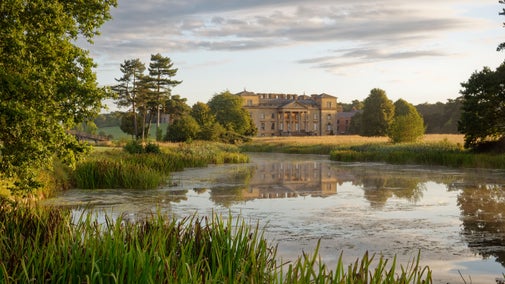
Donate
Everyone needs nature, now more than ever. Donate today and you could help people and nature to thrive at the places we care for.

Each winter we carry out vital conservation work on the estate. Discover some of the outdoor work that the National Trust Rangers team carries out at Ickworth, from managing the spread of ash dieback and maintaining the River Linnet to keeping tabs on a new family of barn owls.

National Trust places across the country are faced with a rise in ash dieback. Ickworth Ranger Matt Bevan details the work that’s being carried out to tackle the spread on the Ickworth estate.
‘A diseased ash tree that’s 20-30 years old will gradually decline before eventually dying after around five years. Larger trees seem to be more resilient, though we’ve still seen signs of dieback.
'At Ickworth, around a quarter of our woodland (60 hectares) is made up of ash trees, and there are more across the parkland. Our current situation is that around 75 per cent of our ash trees are infected with the disease and in some stage of decline.’
‘One of the obvious signs of ash dieback is that the tree will have very few leaves on its branches. As the condition worsens, branches die off altogether and won’t produce any leaves at all. The branches then become brittle, making it more likely that they’ll snap.
'This becomes an issue if the tree is positioned over a path. Over time, more major sections of the tree may weaken, and larger sections could fall. Potentially, the whole tree could come down in time.’
‘At Ickworth, we survey all property boundaries, gardens and car parks, the play area, the multi-use trail and all other waymarked trails.
'The aim is to identify ash trees that have at least 50 per cent canopy loss, which is thought to be the stage where the tree is past the point of recovery and will pose a safety risk in the near future. While some trees are only just at this stage, others are nearing the stage where they’re completely dead.
‘We identified more than 1,100 trees with at least 50 per cent canopy reduction, half of which have needed to be dealt with by contractors due to their proximity to buildings, power lines or such like as this requires specialist equipment that we don't hold on the estate. The other half we have been able to deal with by the in-house felling teams at Ickworth. The survey work is ongoing so if you are walking around Ickworth, you may notice pink spray dots on some of the ash trees.'
‘Areas with significant numbers of infected trees include Lownde Wood and Lady Katharine’s Wood. Main routes will be kept open in the long term. However, less well-used routes with large numbers of infected trees may have to be closed off for a while.’
‘Many insects, invertebrates, lichens and mosses rely on ash as their habitat, and the timber is valued for a wide range of uses.
‘It isn’t all bad news, though; with areas of the woodland being cut back, more light will come in and it’ll encourage flowers, scrub and other species.
‘Additionally, some trees aren’t showing signs of dieback, so these will be left alone and monitored in the hope that they’re resilient to the disease.’

The Ickworth Rangers team has been working with Norfolk River Trust wildlife advisors to assess the opportunities for enhancing wildlife along the River Linnet, which runs through the Ickworth estate.
Generally, the river is looking in good condition, with the more 'natural' areas providing the best habitat for wildlife. These include the part where the river meanders between the Fairy Lake and the Canal, and the section close to the White House. Here, hawthorn, willow and other tree species provide dappled shade, while deadwood falls into the river, creating blockages, changing the flow, and creating more natural meanders, riffles and pools.
Some parts of the river – for instance, the stretch that runs through Saxham End – have very little shade and are pretty much dead straight. Along this section, we've been undertaking some recommended work such as planting hawthorn and willow. When grown, these plants will provide shade for a variety of species.
Barn owls have been spotted nesting in the Ickworth estate for the first time in over 20 years. The family was discovered on land that had previously been taken out of arable production. This freed it from chemicals and intense management, which helped improved the soil structure and vegetation – making it the prime place for mammals to thrive.
We’ve already had a visit from the Suffolk Barn Owls Community Project to record the young barn owls.
As part of our management plan, we want to make our parkland as biodiverse as possible; to improve the natural habitat and encourage as much wildlife as possible to call Ickworth their home. Among other things, this will involve planting more wildflowers to attract wildlife to the estate.
With your ongoing support, we're able to continue our vital conservation work. Thank you for helping to protect these special places.

Everyone needs nature, now more than ever. Donate today and you could help people and nature to thrive at the places we care for.
Discover how Ickworth completed a major conservation project to repair the Rotunda roof and safeguard the future of this classic Italianate building for years to come.
Discover the house and the treasures collected by the flamboyant 4th Earl of Bristol at Ickworth, a magnificent Italianate palace in the heart of Suffolk.

Ickworth's garden was the first of its kind in the UK. Designed for privacy, space and freedom, it's a distillation of the gardens of classical Italy given an individual English touch.

Explore the parkland at Ickworth, encircled with layers of history, landscape and classic architecture. Enjoy space, freedom and inspiring views as you wander at your leisure.

Ickworth is home to one of the most important collections of 18th-century silver in Europe. Learn more about the collection at Ickworth in Suffolk.

There are many different ways that volunteering with the National Trust at Ickworth can benefit you. Find out more and meet a member of the team.

We believe that nature, beauty and history are for everyone. That’s why we’re supporting wildlife, protecting historic sites and more. Find out about our work.

Read about our strategy, which focuses on restoring nature, ending unequal access and inspiring more people.
